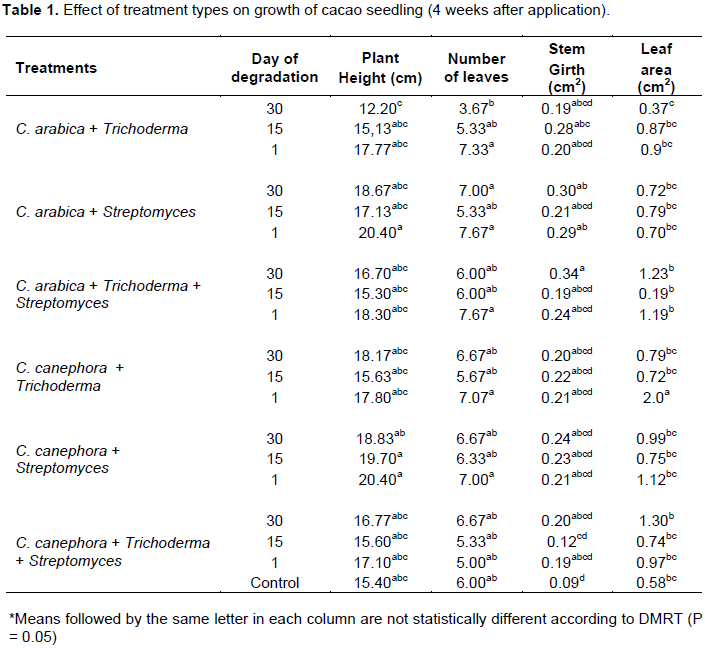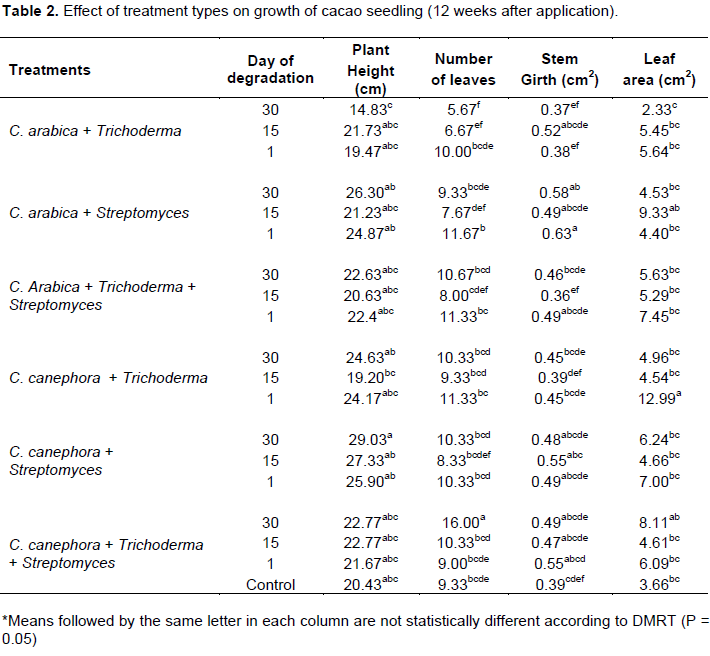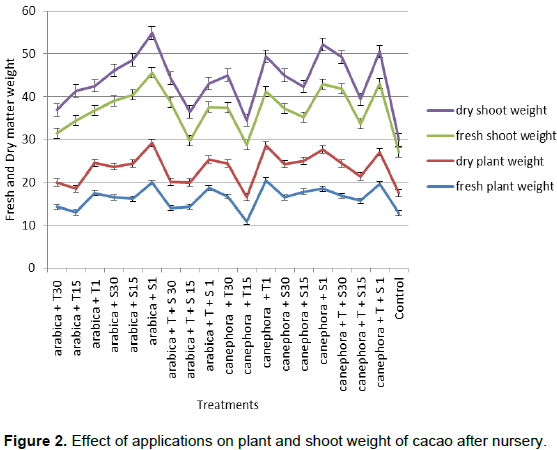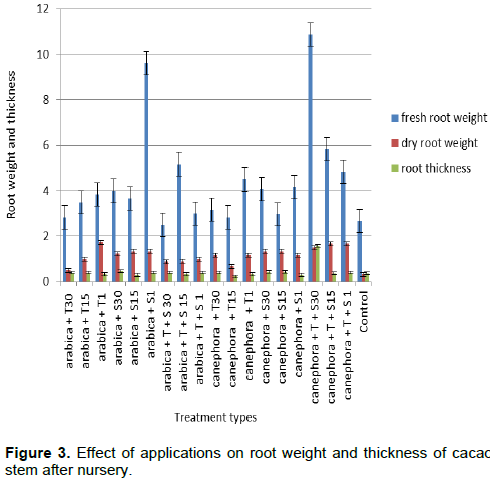ABSTRACT
Cacao is a major economic crop in West Africa and some other parts of the world and is grown through nursery prior to field establishment. The husk of Coffea species forms over 40% of the matured seeds and is regarded as a waste despite its nutrient composition status. Husks of Coffea arabica and Coffea canephora were degraded using Trichoderma harzianum, Streptomyces spp. and the combination of these microbes for 1, 15, and 30 days. Each of bio - degraded C. arabica and C. canephora husks was added to a 2 - week old F3 amazon cacao variety in a nursery experiment laid out in a completely randomized design (CRD). The effect of ameliorated cacao seedling gave positive enhancement of growth performance of cacao in terms of plant height, number of leaves, stem girth and leaf area. The effect of T. harzianum and Streptomyces degraded C. arabica was more evident on cacao growth at 4 weeks after application but T. harzianum and Streptomyces degraded C. canephora significantly enhanced cacao growth performance at termination of the study. The 30-day T. harzianum combined with Streptomyces degraded C. canephora husk showed the best plant height (37.47 mm), number of leaves (27.33), fresh root weight (10.87g) and root thickness (1.57 µm). The highest fresh shoot weight (18.53 mm) was recorded in 30-day T. harzianum combined with Streptomyces degraded C. arabica husk and a day T. harzianum degraded C. canephora husk was the best in fresh plant weight (20.50 g) at the end of the nursery experiment. There were reduced acidity of the soil and an addition of macro nutrients and organic matter contents by the bio-degraded C. arabica and C. canephora husk in the soil. The cacao seedlings were however free of any disease or insect-pest infestation.
Key words: Cacao, amelioration, nursery, soil fertility, coffee husk, bio-degradation.
Theobroma cacao L. is one of the important perennial crops worldwide due to its economic relevance for chocolate and cosmetics industries (Almeida and Valle, 2007). However, good nursery establishment determines growth of cocoa economy and 80% of seedlings are polythene however, bags - grown which have greater chances of establishment and survival after transplanting (Opeke, 2006). Rhodes (1995) opined that hybrid cocoa seedlings raised in nursery are deficient in phosphorous, potassium, calcium, magnesium and effective cation exchange capacity (ECEC) in the soil used for production.
Coffee (Coffea species) is another important commodity in Nigeria because of the economic value of its berry, the husk forms over 40% of the matured seeds and it is a major bye-product from the coffee processing industry and regarded as a waste. Coffee husk compost contains plant nutrients of 2.07% N, 0.55% P2O5 and 2.87% K2O and it influences crop yields (Dzung et al., 2013). The husk is however being utilized as fertilizer in cashew nursery (Nduka et al., 2015); it is also rich in lignocelluloses materials, which make it ideal substrate for microbial processes. Divakaran and Elango (2009) however reported that coffee husk contains appreciable amount of pectin, tannin which favors rapid growth of microorganisms.
Trichoderma spp. are bio-control agent (Howell, 2003; Adeniyi et al., 2013), that help plants to withstand abiotic stresses and also improved the water holding capacity of soil (Mastouri et al., 2010), decomposed organic materials, suitable organization of soil fertility (Guimarães et al., 2013), and promoting the growth of plants in greenhouse and field (Kaewchai et al., 2009). These Microbial inoculants improved Nitrogen (N) fixation or indirectly improved the nutrient availability in the soil to facilitate plants growth (Mc Near, 2013). Trichoderma spp. have been reported for lots of crops (Hermosa, 2012; Hoyos-Carvajal et al., 2009; Kaewchai et al., 2009). Bae et al. (2009) reported that T. hamatum induce tolerance in cocoa against water deficit through increasing root growth.
Bio-fertilizers have been successfully used not only to control plant diseases but also to promote the growth and development of plants in nursery greenhouse and field production. This study thus evaluates T. harzianum and Streptomyces spp - degraded coffee husk to enhance nursery performance of cacao seedling.
Sources of materials
Coffee husk samples of C. arabica and C. canephora were collected from Crop Processing Unit and pure cultures of Trichoderma harzianum and Streptomyces spp. were sourced from Plant Pathology laboratory both of Cocoa Research Institute of Nigeria, Ibadan, Nigeria.
Preparation and bio - degradation of coffee husk
Fifty grams (50 g) of dried coffee husk samples were weighed separately into 100 ml of sterile distilled water in 500 ml beakers, agitated vigorously and stirred continuously for 10 to 15 minutes. Each beaker was covered with aluminium foil, autoclaved at 121°C for 15 min and allowed to cool on a laboratory bench. A 10 mm inoculum disc pure culture of T. harzianum and Streptomyces spp. was inoculated first separately and combined into different sterilized weighed coffee husks in 500 ml beakers. The degradation of the husks was allowed over 1, 15 and 30 days and sterilized coffee husk without either T. harzianum or Streptomyces spp. served as control. The husks with the inocula were incubated at ambient temperature (28° ± 2°C) on a shaker to allow homogenized degradation for the specified periods. The mixtures in beakers were maintained under sterile conditions and covered with sterile foil. At specified period of degradation, each coffee husk mixture was oven dried and maintained for further studies.
Assay of degraded coffee husk in nursery
The 2 - week old F3 amazon cocoa were raised in polythene bags containing 5kg of soil, incorporated with 6.25 g of 1, 15 and 30-day each of bio-degraded coffee husk arranged in a completely randomized design (CRD) for each of C. arabica and C. canephora. The applications and control were replicated in triplicates and data on vegetative growth parameters such as plant height, stem girth, leaf area, and number of leaves, started 4 weeks after application and subsequently recorded 12 and 24 weeks after application. The nursery experiment was terminated at 26 weeks after planting. The cocoa seedlings were harvested, sub-divided into parts: roots, stems and leaves and fresh weight recorded and plant parts were separately oven-dried and weighed. The plant samples were analyzed according to the standard methods of Association of Official Analytical Chemists (AOAC) (1990).
Data analysis
All data obtained were subjected to statistical analysis using the analysis of variance and differences between treatments means were separated by Duncan Multiple Range Test (DMRT) at 5% probability level.
The performance of cacao seedlings ameliorated with coffee husk degraded at varying periods using T. harzianum showed significant variations in growth parameters. At 4 weeks after applications, cacao seedlings treated with a day Streptomyces degraded C. arabica husk gave the best plant height (2.40 mm) and was not significantly different from seedlings ameliorated with 1 day and 15 days Streptomyces degraded C. canephora. The other treatments were not significantly different from the control except the 30 days T. harzianum degraded C. arabica husk. The highest number of leaves was recorded in varied periods of degradations of C. arabica husk with T. harzianum, Streptomyces or both and C. canephora degraded with T. harzianum or Streptomyces were not significantly different (Table 1). The essence of biological degradation of the coffee husk was to increase the fertility of the soil and make available the nutrients from the added sources to the cocoa seedling and the solubility action of organic acids produced during the decomposition of organic matter (coffee husk) applied resulting in more release of native and as well applied nutrients which corroborate the findings of Bellakki et al. (1998).

The result obtained also showed that 30-day T. harzianum combined with Streptomyces degraded C. arabica husk gave the thickest (0.34 cm2) stem in term of girth and the highest leaf area recorded in cacao seedlings ameliorated with a day T. harzianum degraded C. canephora and was significantly higher than other applications and the control (Table 1). Table 2 shows the growth pattern of cacao seedlings at 12 weeks after application, which followed a similar trend of performance as plant height was the least (14.83 cm) in 30-day T. harzianum degraded C. arabica husk and highest recorded in 30-day Streptomyces degraded C. canephora husk and some other applications were significantly comparable. The 30-day T. harzianum combined with Streptomyces degraded C. canephora husk recorded the highest number of leaves in cacao. One day Streptomyces degraded C. arabica husk and a day T. harzianum degraded C. canephora husk recorded 0.63 and 12.99 cm2 as the best stem girth value and leaf area, respectively (Table 2).

According to Mora et al. (1999) coffee husk is a material that has low moisture holding capacity with a very short lifespan, as its decays in a short time and its environmentally alternative material in agriculture (Leifa et al., 2001). Cocoa being a perennial plant, the effectiveness of its growth rate ability can be monitored in the seedling period and as a result when transferred to the field, its performance and yield will be better. Earlier workers have reported the advantage of using high quality organic manure for better crop growth and biomass accumulation (Preetu, 2004 and Vijaya, 2007). It was reported that chemical fertilizer was easy for uptake, but using the compost needed long time to degrade and mineralize and express effectiveness.
The cocoa seedlings plant height and number of leaves at 24 weeks after planting were significantly enhanced when a combination of T. harzianum and Streptomyces was used to degrade C. canephora husk for 30days. But the trend was different with stem girth and leaf area as it significantly improved cocoa seedling performance with a day of degradation of C. canephora husk using T. harzinum and Streptomyces treatments, respectively. However, the control treatment was significantly lower compared to other applications and significant similarities were also recorded in growth parameters ameliorated with different applications (Figure 1a).

The stem girth was significantly higher (1.56 cm2) in C. canephora degraded for a day by Streptomyces and significant similarity were recorded in stem girth treated with C. Arabica degraded with Trichoderma for a day and 15 days, Streptomyces degraded C. arabica for 15 days, C. canephora degraded with Trichoderma for 30 days and combinations of a day degraded C. canephora, Trichoderma and Streptomyces. The stem girth of untreated control was significantly thinner than all treat-ment (Figure 1b).
The T. harzianum and Streptomyces degraded coffee husk showed significant variations in fresh and dry plant weights. The dry weight was significantly high in C. arabica and C. canephora husks at 1 day degradation and differed significantly from control either T. harzianum or Streptomyces was used to degrade the coffee husk (Figure 2). The shoot fresh weight was similarly comparable in all treatments whereas the dry weight shows significant difference only when the husk was degraded for 1 day using Streptomyces. In the root, a 30-day T. harzianum and Streptomyces degraded C. canephora husk increased the root thickness by 1.57 mm when compare to other applications (Figure 2).

Figure 3 showed the effect of treatment types on the fresh and dry root weight and its thickness. The fresh root weight of a 30-day T. harzianum degraded C. canephora treated cacao seedling was significantly higher than other treatments; it was also the same for the fresh root of cacao treated with 15-day Streptomyces degraded C. arabica husk while other applications had significant similarities in their fresh root weight.

However, a day T. harzianum degraded C. arabica husk had the highest dry root weight but not significantly different from 1 and 15-day combined T. harzianum and Streptomyces degraded C. canephora husk; but the control gave the least dry root weight. Distinct cacao root thickness enhancement was recorded in 30-day T. harzianum degraded C. canephora husk which was significantly different from other applications and control while other treatment were similar. A combination of T. harzianum and Streptomyces degraded C. canephora husk will enhance good vigour of cacao seedling. There was no significant variation in fresh root weight of bio-degraded C. arabica but C. canephora degraded coffee husk showed variations in fresh root weight. The reverse is however the case for dry root weight between bio-degraded C. Arabica and C. canephora.
Table 3 showed C. arabica decomposed with Trichoderma spp was significantly higher in soil pH, other treatments also reduced acidity of the soil and both Trichoderma and Streptomyces decomposed C. arabica enhances the organic carbon content in soil. The combined Trichoderma and Streptomyces decomposed C. canephora used as soil amendment increases the macro nutrients and organic matters of the soil. The content of mineral nutrients and organic matters was increased in the soil in this study and was translated to uptake of such by cacao seedlings. Westerman and Bicudo (2005) reported that increase in using organic fertilizer contributed to improve the physical, chemical and biological characteristics of soil and sustainable agricultural cultivation. The high level of phosphorus both in the soil residue and leaf was reported by Young (1994); he also reported that the level of phosphorus is important in determining the quality of the compost as phosphorus is an essential nutrient in plant growth. In addition, the activity of effective microorganisms in the compost such as Trichoderma, and Streptomyces also plays important roles in increasing the uptake of mineral nutrients and fertility of soil for cacao.

However, no significant difference was recorded in the nitrogen (N), Magnesium (Mg) and Potassium (P) contents of bio-degraded C. arabica and C. canephora soil except in Trichoderma and Streptomyces degraded C. canephora husk but the N, P, K were higher than in the initial soil. This implies addition of the macro elements and organic matter contents by the bio-degraded C. arabica and C. canephora husk to the soil. However significant differences were recorded in the quantity of the macro elements and organic matter content of the soil among the treatments. The only variation was recorded in Trichoderma degraded C. arabica husk which reduced the organic content of the soil. The post treatment evaluation of the cacao seedlings for disease and insect-pest status showed they are healthy and free of infestation.
The high organic carbon reported in this study is also similar to the earlier work of Young (1994) which implies that high organic carbon provides preliminary energy source to provide good quality compost. The reduce pH recorded in soil samples after treatment application was similar to the finding of Jahromi et al., (2011) which reported that biological treatment reduces the pH. The change in pH value may be associated with the increase in amino nitrogen content and the presence of metabolic waste products within the substrates. The increase in soil pH in this study also corroborate the earlier findings of Izolda, (2001) which reported pH < 4 was potentially toxic organic acid and if increased in soil solution above 5.5, nitrogen (in the form of nitrate) is made available to plants. Phosphorus made available to plants when soil with pH 6.0 to 7.0 and pH of 6.99 in this study had 11.84% available phosphorus for cocoa plant development when the C. canephora husk was decomposed with a combination of Trichoderma and Streptomyces spp for a period of 30 days.The findings in this study are also comparable to the work of Rudresh et al. (2005) and Shaban and El-Bramawy (2011) that described the improvement in growth parameters under glasshouse and field experiments due to the combined inoculation of Trichoderma spp. with other fungus. Therefore, Trichoderma with Streptomyces spp can be used for bio-decomposition of coffee husk and added as a good substitute for producing positive growth of cocoa seedlings by improving the soil fertility.
This also corroborate the findings of Harman (2006) which reported that Trichoderma - plant association, instead of producing deleterious effect, are of benefits to the host plant in health, growth, and productivity. It was reported that Streptomyces spp. enhanced growth and performance of the crop plants Brown (1974), while Trichoderma sp are also reported as growth promoting fungi by enhancing the availability of nutrients and minerals (N and P) for plants, producing plant growth hormones and decomposing organic material (Kaewchai et al., 2009), and inducing tolerance in cocoa plants against water deficit through increasing root growth (Bae et al., 2009).
The amelioration of cacao seedling using T. harzianum and Streptomyces degraded coffee husks positively enhanced nursery performance of cacao. The effect of T. harzianum and Streptomyces degraded C. arabica was more evident on growth during initial stages, however T. harzianum and Streptomyces degraded C. canephora gave a lasting effect on cacao growth by end of nursery experiment. A combination of 30-day T. harzianum and Streptomyces degraded C. canephora husk gave the best plant height, number of leaves, fresh root weight and best vigour of root thickness, but 30-day T. harzianum combined with Streptomyces degraded C. arabica husk gave best fresh shoot weight and a day T. harzianum degraded C. canephora was best in fresh plant weight by the end of nursery experiment. There was increase in the macro elements and organic matter contents by the bio-degraded C. arabica and C. canephora husk in the soil. These treatments could be further tried on field establishment to determine their effect on field performance and yield of cacao.
The authors have not declared any conflict of interest
REFERENCES
|
Adeniyi DO, Adedeji AR, Oduwaye OF, Kolawole OO (2013). Evaluation of Biocontrolagents against Lasiodiplodia theobromae causing Inflorescence blight of Cashew in Nigeria. IOSR J. Agric. Vet. Sci. 5(3):46-48.
Crossref
|
|
|
|
Almeida AAF, Valle RR (2007).Ecophysiology of the cacao tree. Braz. J. Plant Physiol.19:425-448.
Crossref
|
|
|
|
|
AOAC (1990). Official Methods for Analysis of the Association of Official Analytical Chemists 15th Edition. Helrich K (ed), Arlington Virginia. Washington D.C.
|
|
|
|
|
Bae H, Sicher RC, Kim MS, Kim SH, Strem MD (2009). The beneficial endophyte Trichoderma hamatum isolate DIS 219b promotes growth and delays the onset of the drought response in Theobroma cacao. J.
Crossref
|
|
|
|
|
Bellakki MA, Badnur VP, Shetty RA(1998). Effect of long term integrated nutrient management on some important properties of vertisols. J. Ind. Soc. Soil Sci. 46:176-180.
|
|
|
|
|
Brown ME (1974). Seed and root bacterization. Ann.Rev. Phytopathol. 12:181-197.
Crossref
|
|
|
|
|
Divakaran J, Elango R (2009). Microbial consortium for effective composting of coffee pulpwaste by enzymatic activities. Global J. Environ. Res. (3):92-95.
|
|
|
|
|
Dzung T, Dzung T,Khanh VTP (2013). Evaluation of coffee husk compost for improving soil fertility and sustainable coffee production in rural central highland of Vietnam. Res. Environ. 3(4):77-82.
|
|
|
|
|
Guimarães DV, Silva-Gonzaga MI, Silva TO, Silva TL, Silva DN, Silva-Matias MI (2013).Soil organic matter pools and carbon fractions in soil under different land uses. Soil and Tillage Res. 126:177-182.
Crossref
|
|
|
|
|
Harman G (2006). Overview of mechanisms and uses of Trichoderma spp. Phytopathology 96:190-194.
Crossref
|
|
|
|
|
Hermosa R, Viterbo A, Chet I, Monte E (2012). Plant beneficial effects of Trichoderma and of its genes 158(P61):17-25.
|
|
|
|
|
Howell CR (2003). Mechanisms employed by Trichoderma species in the biological control of plant disease; the history and evolution of current concepts. Plant Dis. 87:4-10.
Crossref
|
|
|
|
|
Hoyos-Carvajal L, Orduz S, Bissett J (2009). Growth stimulation in bean (Phaseolus vulgaris L.) by Trichoderma. Biol. Control 51(3):409-416.
Crossref
|
|
|
|
|
Izolda T (2001). Image of pH scale, information derived from: "Nutrient Manager: Focus on pH and Lime", published by the University of Maryland's Cooperative Extension Service and Department of Agronomy; The Handbook of Soils and Climate in Agriculture; theTop soil on Tour Mini Curriculum and Hands on Test Kit by the LaMotte Company, and the Miami Museum of Science.
|
|
|
|
|
Jahromi MF, Liang JB, Rosfarizan M, Goh YM, Shokryazdan P, Ho YW (2011). In: Efficiency of rice straw lignocelluloses degradability by Aspergillus terreus ATCC 74135in solid state fermentation. Afr. J. Biotechnol. 10(21):4428-4435.
|
|
|
|
|
Kaewchai S, Soytong K, Hyde KD (2009). Mycofungicides and fungal biofertilizers. Fungal diversity. 38:25-50.
|
|
|
|
|
Leifa F, Pandey A, Soccol CR (2001). Production of flammulina velutipes on coffee husk and coffee spent-ground, "Braz. Arch. Biol. Technol. 44(2):205-212.
Crossref
|
|
|
|
|
Mastouri F, Bjorkman T, Harman GE (2010). Seed treatment with Trichoderma harzianum alleviates biotic, abiotic and physiological stresses in germinating seeds and seedlings. Phytopathology 100:1213-1221.
Crossref
|
|
|
|
|
Mc Near Jr DH (2013). The Rhizosphere - Roots, Soil and Everything In Between. Nat. Educ. Knowl. 4(3):1.
|
|
|
|
|
Mora A, Russell DW, Dungy CI, Losch M, Dusdieker L (1999). The Iowa Infant Feeding Attitude Scale: Analysis of Reliability and Validity. J. Appl. Social Psychol. 29(11):2362-2380.
Crossref
|
|
|
|
|
Nduka BA, Adewale DB, Akanbi OSO, Adejobi KB (2015). Nursery Soil Amendments for Cashew Seedling Production: A Comparative Analysis of Coffee Husk and NPK. J. Agric. Sci. 7(3):111.
Crossref
|
|
|
|
|
Opeke LK (2006). Tropical Tree Crops. Spectrum Books Ltd. Pub. Ilorin: Woye and SonsNigeria Ltd.
|
|
|
|
|
Preetu (2004). Evaluation of quality, maturity indices and agronomic efficiency of compost prepared using coffee husk and pulp. M.Sc. (Agri.) Thesis, Univ. Agric. Sci. Bangalore (India).
|
|
|
|
|
Rhodes ER (1995). Nutrient depletion by food crops in Ghana and soil organic nitrogen management. Agric. Syst. 48(1):101-118.
Crossref
|
|
|
|
|
Rudresh DL, Shivaprakash MK, Prasad RD (2005). Effect of combined application of Rhizobium, phosphate solubilizing bacterium and Trichoderma spp. on growth, nutrient uptake and yield of chickpea (Cicer aritenium L.). Appl. Soil Ecol.28:139-146.
Crossref
|
|
|
|
|
Shaban WI, El-Bramawy MA (2011). Impact of dual inoculation with Rhizobium andTrichoderma on damping off, root rot diseases and plant growth parameters of some legumes field crop under greenhouse conditions. Int. Res. J. Agric. Sci. Soil Sci. 1(3):098-108.
|
|
|
|
|
Vijaya KN (2007). Effect of coffee pulp effluent on growth and yield of
|
|
|
|
|
Westerman PW, Bicudo JR (2005). Management considerations for organic wastes use in agriculture. Bioresour. Technol. 96:215-221.
Crossref
|
|
|
|
|
Young CC (1994). Selection and application of biofertilizers in Taiwan Agriculture. In: International Seminar on the Use of Micro Organic Fertilizers for Agricultural Production. Rural Development Administration of Korea and Food and Fertilizer Technology Center, Suwon pp. 147-165.
|
|